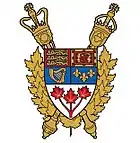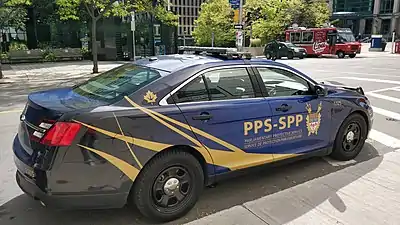Parliamentary Protective Service
The Parliamentary Protective Service (PPS; French: Service de protection parlementaire) is an entity of the Parliament of Canada created by law that is mandated to provide physical security for parliamentarians, employees, and visitors within the Parliamentary Precinct in Ottawa, Ontario.
| Parliamentary Protective Service Service de protection parlementaire | |
|---|---|
 Official emblem[lower-alpha 2] | |
| Abbreviation | PPS (SPP in French) |
| Agency overview | |
| Formed | June 23, 2015[1] |
| Preceding agencies |
|
| Employees | ~600 (2018) |
| Annual budget | CA$91,100,000[2] |
| Jurisdictional structure | |
| Operations jurisdiction | Canada |
| Governing body | Parliament of Canada |
| Constituting instrument | |
| General nature | |
| Operational structure | |
| Elected officers responsible | |
| Agency executive |
|
| Divisions | National Division: National Capital Region |
| Website | |
| pps | |
The Director of the PPS is a member of the Royal Canadian Mounted Police (RCMP) and operates under policies set by the Speakers of the Senate and House of Commons.[4] PPS provides physical security services to the Parliament of Canada (parliamentarians, employees, visitors and buildings of the Parliamentary Precinct), and acts as a parliamentary entity. Protection of the Prime Minister of Canada still remains with the RCMP Protective Policing Services.
While the Director of the PPS must be a member of the RCMP by law, he or she controls and manages the organization's daily operations.[3] The Director executes his or her mandate under the joint general policy direction of the Speaker of the Senate and the Speaker of the House of Commons. The Speakers of both Houses, being responsible for PPS, and the Minister of Public Safety and Emergency Preparedness have entered into an arrangement to have the RCMP lead the physical security operations of PPS.
History
On October 22, 2014, Michael Zehaf-Bibeau evaded security and entered the Hall of Honour with a rifle and a knife after fatally shooting Corporal Nathan Cirillo of The Argyll and Sutherland Highlanders of Canada (Princess Louise's), injuring a constable.[5][6] On November 2014, the Joint Advisory Working Group on Security identified lack of communication among security groups at Parliament Hill as a significant problem,[7] and recommended combining the existing security forces under the Senate, the House of Commons and RCMP detachment in charge of the grounds into one integrated security service. Parliament subsequently passed Bill C-59, which mandated this change.[8]
By June 23, 2015, the PPS was created by law under an amendment to the Parliament of Canada Act. The Speaker of the Senate and the Speaker of the House of Commons were, as the custodians of the powers, privileges, rights and immunities of their respective Houses and of their members, responsible for the PPS. The newly created parliamentary entity amalgamated the former Senate Protective Service, House of Commons security, and detection specialists, under a single unified security service to serve the Parliament of Canada.
Subsequently, the new Parliamentary Protective Service began, starting with changes in weaponry, radio communication and surveillance equipment.[9] One indication of increased security at Parliament Hill is the appearance of RCMP officers armed with carbines in front of the buildings.[7] About 30 new RCMP officers were added to the newly formed PPS. A Member of Parliament pointed out that not all of the officers in the unit spoke French, creating a potential for problems when directing the public during an emergency.[10]
In June 2016, the members of the new service were provided with uniforms designed to identify them as members of PPS.[11]
In November 2016, PPS constables stopped a man from entering the Centre Block with a meat cleaver.[12]

Notes
- The emblem incorporates key visual elements from each of the partnering institutions that make up PPS. The Senate and House of Commons are represented by the Parliament coat of arms and surrounded by gold maple leaves similar to those used in the RCMP emblem. The combination of these elements represents the unification of the Senate and House of Commons Protection Services with the former Parliament Hill Security Unit.
- The emblem incorporates key visual elements from each of the partnering institutions that make up PPS. The Senate and House of Commons are represented by the Parliament coat of arms and surrounded by gold maple leaves similar to those used in the RCMP emblem. The combination of these elements represents the unification of the Senate and House of Commons Protection Services with the former Parliament Hill Security Unit.
References
- "Welcome". Parliamentary Protective Service. Retrieved 2017-01-30.
- "2018-2019 BUDGET". Parliamentary Protective Service. Retrieved 2020-04-26.
- Parliamentary Protective Service Directors
- "Parliament of Canada Act". Justice Laws Website. Justice Canada. Retrieved 23 May 2016.
- MacLeod, Ian (8 May 2015). "New Parliamentary Protective Service officially unveiled". Ottawa Citizen. Retrieved 22 December 2016.
- Thibedeau, Hannah (14 May 2015). "RCMP hiring 30 officers for new Parliament Hill security force". CBCNews. Retrieved 22 December 2016.
- MacLeod, Ian (21 October 2016). "Could Zehaf-Bibeau have made it past today's 'armed to the teeth' Hill security?". Ottawa Citizen.
- Thibedeau, Hannah. "RCMP hiring 30 officers for new Parliament Hill security force". CBCNews. CBC/Radio-Canada. Retrieved 23 May 2016.
- MacCharles, Tonda (21 October 2015). "Parliament Hill security reinforced in wake of Oct. 22 attacks". The Hamilton Spectator.
- "English-only RCMP officers on Parliament Hill spark complaints". CBCNews. 27 April 2016.
- Levitz, Stephanie (16 June 2016). "Old, new Parliament Hill security expose tensions over social media". Toronto Star. The Canadian Press.
- "Toronto man arrested on Parliament Hill allegedly carried a meat cleaver". Global News. The Canadian Press. 18 November 2015.